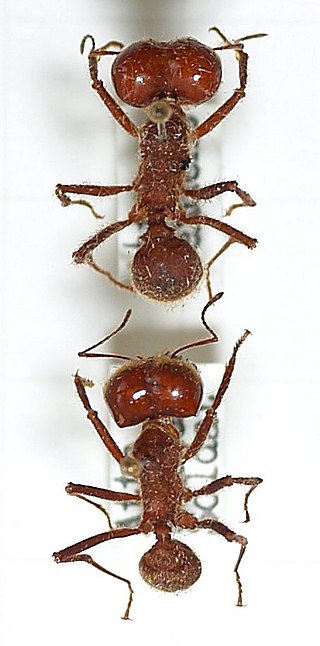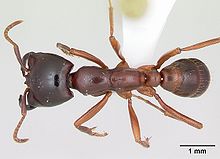
Ants are eusocial insects of the family Formicidae and, along with the related wasps and bees, belong to the order Hymenoptera. Ants evolved from vespoid wasp ancestors in the Cretaceous period. More than 13,800 of an estimated total of 22,000 species have been classified. They are easily identified by their geniculate (elbowed) antennae and the distinctive node-like structure that forms their slender waists.

An ant colony is a population of a single ant species able to maintain its complete lifecycle. Ant colonies are eusocial, communal, and efficiently organized and are very much like those found in other social Hymenoptera, though the various groups of these developed sociality independently through convergent evolution. The typical colony consists of one or more egg-laying queens, numerous sterile females and, seasonally, many winged sexual males and females. In order to establish new colonies, ants undertake flights that occur at species-characteristic times of the day. Swarms of the winged sexuals depart the nest in search of other nests. The males die shortly thereafter, along with most of the females. A small percentage of the females survive to initiate new nests.

Carpenter ants are large ants indigenous to many forested parts of the world.

The name army ant (or legionary ant or marabunta) is applied to over 200 ant species in different lineages. Because of their aggressive predatory foraging groups, known as "raids", a huge number of ants forage simultaneously over a limited area.

Atta sexdens is a species of leafcutter ant belonging to the tribe Attini, native to America, from the southern United States (Texas) to northern Argentina. They are absent from Chile. They cut leaves to provide a substrate for the fungus farms which are their principal source of food. Their societies are among the most complex found in social insects. A. sexdens is an ecologically important species, but also an agricultural pest. Other Atta species, such as Atta texana, Atta cephalotes and others, have similar behavior and ecology.

Eciton burchellii is a species of New World army ant in the genus Eciton. This species performs expansive, organized swarm raids that give it the informal name, Eciton army ant. This species displays a high degree of worker polymorphism. Sterile workers are of four discrete size-castes: minors, medias, porters (sub-majors), and soldiers (majors). Soldiers have much larger heads and specialized mandibles for defense. In lieu of underground excavated nests, colonies of E. burchellii form temporary living nests known as bivouacs, which are composed of hanging live worker bodies and which can be disassembled and relocated during colony emigrations. Eciton burchellii colonies cycle between stationary phases and nomadic phases when the colony emigrates nightly. These alternating phases of emigration frequency are governed by coinciding brood developmental stages. Group foraging efforts known as "raids" are maintained by the use of pheromones, can be 200 metres (660 ft) long, and employ up to 200,000 ants. Workers are also adept at making living structures out of their own bodies to improve efficiency of moving as a group across the forest floor while foraging or emigrating. Workers can fill "potholes" in the foraging trail with their own bodies, and can also form living bridges. Numerous antbirds prey on the Eciton burchellii by using their raids as a source of food. In terms of geographical distribution, this species is found in the Amazon jungle and Central America.

Nuptial flight is an important phase in the reproduction of most ant, termite, and some bee species. It is also observed in some fly species, such as Rhamphomyia longicauda.

Crematogaster is an ecologically diverse genus of ants found worldwide, which are characterised by a distinctive heart-shaped gaster (abdomen), which gives them one of their common names, the Saint Valentine ant. Members of this genus are also known as cocktail ants because of their habit of raising their abdomens when alarmed. Most species are arboreal (tree-dwelling). These ants are sometimes known as acrobat ants.

Acromyrmex is a genus of New World ants of the subfamily Myrmicinae. This genus is found in South America and parts of Central America and the Caribbean Islands, and contains 33 known species. Commonly known as "leafcutter ants" they comprise one of the two genera of advanced attines within the tribe Attini, along with Atta.

Eusociality, is the highest level of organization of sociality. It is defined by the following characteristics: cooperative brood care, overlapping generations within a colony of adults, and a division of labor into reproductive and non-reproductive groups. The division of labor creates specialized behavioral groups within an animal society which are sometimes referred to as 'castes'. Eusociality is distinguished from all other social systems because individuals of at least one caste usually lose the ability to perform behaviors characteristic of individuals in another caste. Eusocial colonies can be viewed as superorganisms.

Aenictus is a large army ant genus distributed in the Old World tropics and subtropics. It contains about 181 species, making it one of the larger ant genera of the world.

Carebara diversa, the East Indian harvesting ant, is a species of marauder ant widely distributed throughout Asia.

Tetraponera is a genus of ants in the subfamily Pseudomyrmecinae that are commonly known as slender ants and are characterized by their arboreal nature and slender bodies. The 96 described species of Tetraponera all of which live in hollow structures of plants and trees, such as thorns or branches; these hosts are known as myrmecophytes. Tetraponera species are closely related to the New World genus of ants Pseudomyrmex, but differ in their relationships with host plants.

Dorylus laevigatus is a member of the army ant genus Dorylus, or Old World army ants. More specifically known as "driver ants", the genus Dorylus is abundant throughout Africa and stretches into tropical Asia, where D. laevigatus is primarily found. They are a eusocial colony-forming species, which live primarily underground, rarely venturing to the surface for any reason. D. laevigatus colonies are small for army ants, estimated averages falling between 30,000 and 1,000,000 individuals.
Dorylus molestus is a species of African army ant.

Neivamyrmex is a genus of army ants in the subfamily Dorylinae.

Dorylus gribodoi is a West African species of army ants in the genus Dorylus.

An ergatoid is a permanently wingless reproductive adult ant or termite. The similar but somewhat ambiguous term ergatogyne refers to any intermediate form between workers and standard gynes. Ergatoid queens are distinct from other ergatogyne individuals in that they are morphologically consistent within a species and are always capable of mating, whereas inter caste individuals, another class of ergatogynes, often are not. Ergatoids can exhibit wide morphological differences between species, sometimes appearing almost identical to normal workers and other times being quite distinct from both workers and standard queens. In addition to morphological features, ergatoids among different species can exhibit a wide range of behaviors, with some ergatoids acting only as reproductives and others actively foraging. Ergatoid queens have developed among a large number of ant species, and their presence within colonies can often provide clues on the social structures of colonies and as to how new colonies are founded. Without wings, almost all species of ants that solely produce ergatoid queens establish new colonies by fission.

Megaponera analis is the sole species of the genus Megaponera. They are a strictly termite-eating (termitophagous) ponerine ant species widely distributed in Sub-Saharan Africa and most commonly known for their column-like raiding formation when attacking termite feeding sites. Their sophisticated raiding behaviour gave them the common name Matabele ant after the Matabele tribe, fierce warriors who overwhelmed various other tribes during the 1800s. With some individuals reaching up to 25 millimetres (0.98 in) in length, M. analis is one of the world's largest ants.
This is a glossary of terms used in the descriptions of ants.























